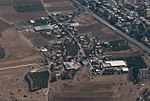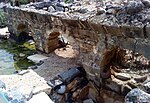Bethmaus
Bethmaus, (Greek: Βηθμαούς) or Beth Maʿon (Hebrew: בית מעון), also called Maon, was a Jewish village during the late Second Temple and Mishnaic periods, and which was already a ruin (Tell Maʿūn) when Kitchener visited the site in 1877. It was situated upon the hill, directly north-west of the old city of Tiberias, at a distance of one biblical mile, rising to an elevation of 250 metres (820 ft) above sea-level. It is now incorporated within the modern city bounds of Upper Tiberias. The remaining structure built over the site is a Sheikh's Tomb. Others place the ancient Bethmaus (Ma'on) where is now the Arab ruin, Khirbet Nadhr ad-Din, saying that with the passing of time, the old namesake was transferred to Tell Maʿūn, a short distance away. The Midrash (Genesis Rabba § 85:7) says of the village, "Beth Maʿon, they ascend to it from Tiberias, but they go down to it from Kefar Shobtai." The Jerusalem Talmud, citing a variant account, says that they would go down to Beth Maʿon from its broad place.
Excerpt from the Wikipedia article Bethmaus (License: CC BY-SA 3.0, Authors).Bethmaus
Kikar Jabotinsky, Tiberias
Geographical coordinates (GPS) Address Nearby Places Show on map
Geographical coordinates (GPS)
| Latitude | Longitude |
|---|---|
| N 32.794444444444 ° | E 35.533333333333 ° |
Address
ככר ז'בוטינסקי
Kikar Jabotinsky
Tiberias
North District, Israel
Open on Google Maps








